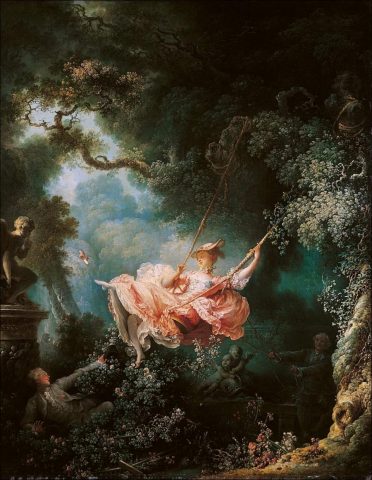Today, I will tell you about the artwork of Jean-Honoré Fragonard, 81 cm x 64 cm, “The Swing”, one of the most important works of the Rococo style, made in 1767 and exhibited in the Wallace Collection in London today.
First of all let me talk about the Rococo style. This style emerges after the Baroque period and is actually born as a reaction to the Baroque style. As an example of Baroque works, you can immediately think of any Caravaggio piece
It is actually a reaction to the rules and strict dimensions of the Baroque style and its heavy atmosphere. Therefore, a softness can be seen in the works in the Rococo style. Symmetrical designs generally used in the Baroque period are replaced by asymmetrical designs.
Both the subjects, the folds and the lines of the works are soft during the rococo period. Generally, instead of the heavy and gloomy subjects we see in Baroque art, fun subjects were preferred. It is a very fun style compared to the Baroque style.
Here I will tell you today, “Swing” is a work that reflects the Rococo style best and is quite enjoyable to study. What gets your first attention when you look at the picture? The woman is of course… With her dress and joy and happiness, she is at the center of the picture both as subject and location.
However, we have two other figures left behind in the picture. On the back there is a figure sitting on the one hand and swinging the swing. This figure is the husband of the woman on the swing. A little old, if you pay attention. The woman is too young and full of life compared to this man.
On the other side, to our left, there is another male figure hidden in the bushes. He is also the woman’s lover. While her husband is shaking the woman, the woman is looking at her lover and throwing her shoes in the air and opening her skirt to her lover.
Almost all the icons in the picture are about deception, love and loyalty. For example, let’s start with the positioning of the woman in the picture. It’s simple, she turned her back on her husband. But it’s not just her husband that she turns her back on. He turns his back on angel figures in the background.
In fact, we see a happy sinner who has turned his back on health and goodness. To his left we see a Cupid, that is, the cupid. The woman seems to leave the angels behind and head towards Cupid. Also, the swing is a very strong symbol. Symbol of indecision, imbalance and turmoil.
Again, you can see that the painter put beautiful details to emphasize the hidden love theme in the painting. The fact that Cupid put his finger on his lip and the sign “be quiet” to the woman also strengthens the forbidden love effect in the picture. “Quiet, your husband will hear!”
Dogs are always loyal friends of man and often symbolize loyalty in pictures. Of course, in this picture, seeing a dog next to the woman’s husband should remind us of loyalty directly. In addition, the barking of the dog against the woman is another great detail:)
Of course, his poor husband never suspects the dog’s barking and is watching his swinging lover in a smile. Let’s get back to the Baroque-Rococo comparison, which I said at the beginning and misunderstood. Let me briefly state that Baroque paintings are according to these Rococo works have more symmetrical forms. So they were not all perfectly symmetrical, of course.
Rococo style is a softer style after dark and gloomy Baroque painting, which came into order in individuality and at some point instead of asymmetric compositions of maniaism and especially stack figures. We often see more fun themed images. Just like in this example. Although the Baroque period breaks the rules, it is a more formal style than Rococo. Rococo manifests itself with softer shades and detailed icons.
Hits: 650

